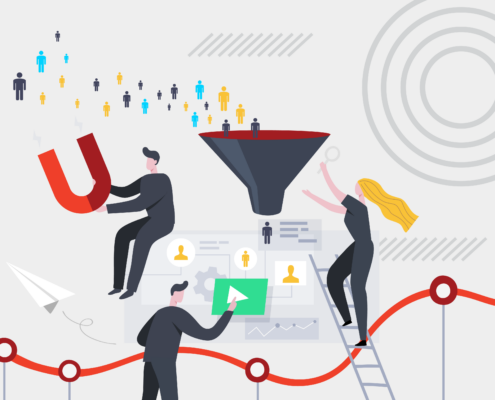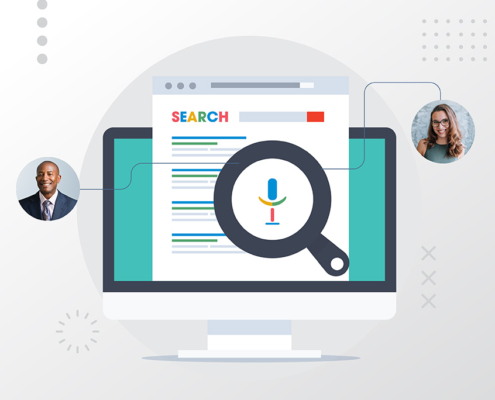

When business owners think of business growth, there are two departments that immediately come to mind: sales and marketing.
While both the sales and marketing sectors do play a crucial role in generating more revenue for your business, there’s a less talked about liaison between the two departments, and that’s the sales enablement team.
To achieve maximum success from your business growth efforts, there must be a sales enablement strategy and team in place to successfully guide prospects and leads from the beginning to the end of the sales funnel. And in this blog, we’ll show you just how to do that for ultimate lead-generating success.
Here’s what we’ll cover throughout this blog:
Definition of Sales Enablement
Sales enablement can be defined as the strategic process of providing sales reps with the information, content, and tools they need to sell more effectively. This includes training, coaching, content development, and sales technology implementation. The goal is to enhance sales productivity, efficiency, and performance.
Key functions of sales enablement include:
- Developing sales content such as presentations, one-pagers, and email templates to be used in the selling process
- Designing and executing sales training programs to improve rep skills and competencies
- Providing ongoing coaching and mentoring to perfect selling techniques and product knowledge
- Analyzing metrics and buyer insights to refine enablement programs to maximize the impact
By handling these strategic activities, sales enablement helps arm customer-facing teams to engage buyers, create a sales pipeline, and ultimately boost revenue. It brings together content, training, and technology to increase sales productivity.
Sales Enablement vs. Sales Operations: What’s the Difference?
Sales enablement and sales operations are two distinct functions within a sales organization, each with its own set of responsibilities and goals. Here’s an overview of the key differences between the two:
Sales Enablement
- Focus: Sales enablement is primarily focused on equipping the sales team with the tools, resources, and training they need to sell effectively. It’s about empowering salespeople to have meaningful conversations with customers and prospects.
- Responsibilities: Sales enablement teams are responsible for creating and delivering sales training programs, developing sales content and collateral, providing sales technology and tools, and ensuring that the sales team has the knowledge and resources to succeed.
- Goal: The primary goal of sales enablement is to improve the productivity and effectiveness of the sales team, ultimately leading to increased revenue.
Sales Operations
- Focus: Sales operations, on the other hand, are focused on optimizing the processes, systems, and data that support the sales organization. It deals with the behind-the-scenes aspects of sales to make sure everything runs smoothly.
- Responsibilities: Sales operations teams are responsible for managing sales processes, configuring and maintaining CRM (Customer Relationship Management) systems, analyzing sales data, forecasting sales performance, and ensuring that the sales team has the necessary infrastructure to operate efficiently.
- Goal: The primary goal of sales operations is to streamline sales processes, improve data accuracy, enhance sales forecasting, and support strategic decision-making within the organization.
While both sales enablement and sales operations play essential roles in a sales organization, they have different areas of focus and responsibilities. Sales enablement is about arming sales teams with the knowledge and resources to sell effectively, while sales operations teams are concerned with optimizing processes and systems to ensure the overall efficiency of the sales organization. Together, they contribute to the success and growth of a company’s sales efforts.
Abstrakt’s sales operation specialists collaborate with growing B2B sales teams to help their businesses secure more revenue through a streamlined lead generation process. Explore how we do it through B2B appointment setting.
Role of Sales Enablement for Business Growth
Sales enablement plays an indispensable role in empowering sales teams and organizations to achieve their targets. Research shows that companies with mature enablement functions grow revenue over twice as fast compared to those still developing programs.
Key benefits provided by sales enablement include:
- Increasing win rates by arming sellers with buyer insights and value messaging
- Shortening sales cycles through content that moves prospects through the buying journey
- This is especially important for B2B (business-to-business) companies as they typically have much longer sales sales than B2C (business-to-consumer) businesses
- Boosting seller productivity by reducing time spent searching for information
- Improving sales and marketing alignment to generate better leads
Additionally, enablement programs lift seller confidence by sharpening their skills and product knowledge. Reps have the assets needed to have productive conversations and close complex, high-value deals.
Why Is Sales Enablement More Important Now Than Ever Before?
While sales enablement has existed in some form for a while, it has evolved substantially in recent years. Trends like digital transformation, remote work, and proliferating sales technologies have made enablement more crucial than ever.
For example, buyers today largely research and evaluate products online before ever talking to a sales rep. This means sellers need to be equipped with digital selling capabilities and content that addresses common pain points and questions.
Additionally, sales enablement as a strategic discipline has matured greatly. Dedicated enablement teams and tech stacks are now commonplace at mid-market and enterprise companies. And sales leaders recognize enablement as vital for scaling revenue growth.
Going forward, sales enablement will only increase in importance, particularly as sellers need guidance to leverage AI and new sales tools. Enablement helps reps stay ahead of the curve and excel in an increasingly digital, fast-paced sales landscape.
How to Develop a Robust Sales Enablement Strategy
Understanding the Key Components
At the core of a successful sales enablement strategy lies the understanding of its key components: content, tools, training, and analytics. A well-rounded strategy effectively aligns these elements with the company’s sales processes and goals to provide sales teams with the necessary resources to engage prospects and close deals proficiently.
Crafting Tailored Content
Customized content is the ammunition your sales team needs to address customer pain points, objections, and queries. Work closely with marketing to ensure that the content created is not only brand-consistent but also tailored to different stages of the buyer’s journey. This can range from case studies and product sheets to educational articles and videos.
Leveraging Advanced Tools
Implementing the right sales enablement tools can dramatically improve the efficiency of sales operations. These tools should not only facilitate content distribution and management but also enhance customer relationship management, sales training, and performance tracking.
Providing Ongoing Training
Sales training is another cornerstone of a robust strategy. Training needs to be continuous to help salespeople develop the acumen for selling products and navigating complex sales scenarios. It should cover product knowledge, sales tactics, and the use of sales enablement tools and content.
Measuring Performance and Impact
Lastly, employing data-driven analytics to measure the impact of your sales enablement initiatives is vital. By analyzing performance data, you can understand what is working, what isn’t, and where there is room for improvement. These insights enable you to refine your strategy and make informed decisions to better support your sales team’s success.
By approaching sales enablement strategically, you create a supportive framework that empowers your sales team to perform at their best, driving growth and revenue for your organization.
Best Practices for Mastering Sales Enablement
Consistent Training and Education for an Advanced Sales Team
A comprehensive training and education program is essential for building a skilled sales team. Sales enablement professionals should develop role-specific training paths covering product knowledge, objection handling, presentation skills, and more. Utilize a blend of formats and resources like videos, job aids, virtual role-playing, and microlearning to drive retention and application.
Some tips for sales training success include:
- Personalize training using sales data and rep feedback surveys
- Incorporate continuous learning with nano learning content, refreshers, and certifications to prevent knowledge decay
- Enable peer-to-peer learning via collaboration tools and best practice sharing
- Provide an incentive for sales reps who are completing trainings
One of the best training tools for sales enablement is LinkedIn Learning. From sales to marketing and lead generation, LinkedIn Learning offers a variety of training opportunities for sales reps to take advantage of to accelerate their sales efforts.
To have the best sales enablement strategy for your business, we suggest providing sales reps with a mentor who can provide them coaching on how they can improve their sales efforts. This includes listening to previous sales calls and pitches and providing them with insights into ways they can increase the likelihood of closing a deal.
Leveraging Technology to Enhance Sales Enablement Efforts
Sales enablement platforms empower teams by centralizing content, training, and other assets while providing visibility through analytics. Leaders should take a strategic approach by aligning technology decisions to overarching sales objectives around conversion rates, deal sizes, and more. Potential solutions include:
- Content management: Organize sales collateral, customize assets, simplify updates
- Buyer engagement: Drive interactions with AI-powered tools for email sequencing, event triggering, and personalized content recommendations
- Performance analytics: Gain visibility into content utilization, training completion rates, and other adoption metrics to optimize programs
To keep track of sales enablement efforts, we suggest using customer relationship management (CRM) software to streamline sales trainings and operations in a unified platform. This enables you to further investigate if there’s more sales success from reps who are taking advantage of training opportunities.
However, technology itself does not guarantee sales success. True transformation requires change management across processes, content, and culture. Enablement leaders should secure executive buy-in, provide extensive training and support, and highlight quick wins. This minimizes disruption during deployment.
Align and Streamline Sales and Marketing Departments
Lack of alignment between sales and marketing is a top obstacle for sales enablement. Conflicting goals and poor communication reduce content effectiveness. Leaders should foster collaboration through strategies like:
- Joint quarterly planning to set shared targets
- Cross-functional asset creation with both perspectives
- Integrated technologies to seamlessly handoff buyers
- Consistent messaging spanning both departments
Additionally, centralizing key content in sales enablement platforms provides transparency. Sales can easily access approved collateral while Marketing gains visibility into utilization. This builds trusted partnerships to propel sales enablement.
Outsource Sales Enablement to a Third-Party Service
Growing businesses should outsource their sales enablement efforts for greater impact because it allows them to tap into specialized expertise and resources.
Outsourcing providers bring a wealth of experience, tools, and best practices to streamline sales processes, accelerate growth, and enhance customer engagement. This frees up internal teams to focus on core business functions, reduces operational costs, and promotes scalability.
Outsourcing also provides access to a broader talent pool, enabling businesses to adapt quickly to market changes and innovate effectively. Ultimately, outsourcing sales enablement leads to improved efficiency, increased revenue, and the flexibility needed to thrive in a dynamic business environment.
For complete insight into what it means to outsource business growth, read our blog here.
How to Measure the Success of Your Sales Enablement Strategy
Implementing an effective sales enablement strategy is crucial, but equally important is having the right metrics and key performance indicators (KPIs) in place to track progress. This allows sales leaders to continually refine the strategy to optimize results.
Analyze Core KPIs for Sales Enablement
Some key metrics to track include:
- Sales readiness: Assess reps’ confidence levels, knowledge, and preparedness to have sales conversations.
- Content usage: Track consumption of sales collateral to see what resonates.
- Sales coaching engagement: Measure coaching session frequency and attendance.
- Tech adoption: Ensure reps utilize your sales tech stack through usage rates.
Leading indicators like these reveal how well your enablement program equips sellers. Compare these early-stage metrics pre- and post-launch to determine enablement ROI.
Assess the Impact Sales Enablement Has Had on Your Bottom Line
While early indicators demonstrate enablement traction, lagging indicators like performance data confirm the bottom-line impact. Analyze:
- Win rates: Higher win rates indicate better-positioned, equipped sellers.
- Deal sizes: Enablement aids reps in landing larger deals.
- Sales cycle length: More effective reps shorten sales cycles.
- Quota attainment: More enabled reps meet goals faster.
Connecting enablement KPIs to revenue metrics shows how better-enabled sellers translate to sales growth. An increase of 5-10% annually confirms a solid return on enablement investments.
Continually Refine Your Sales Enablement Strategy
With clear metrics aligned to revenue and growth, sales leaders can pinpoint what enablement efforts work and what misses the mark. Key improvement strategies include:
- Sales rep feedback: Survey reps on enablement tools, content, and coaching to enhance programs.
- New seller ramp-up analysis: Identify enablement gaps hampering onboarding.
- Tech utilization reports: Double down on highly adopted tech.
- Sales methodology review: Evolve methodology based on rep performance analyses.
Continually realigning enablement to help sellers navigate changing market landscapes is vital. Keep enablement dynamic, not static, for sustained sales success.
What Does the Future of Sales Enablement Look Like?
As sales enablement continues to evolve, there are several key trends, innovations, and strategies that sales teams must prepare for in the coming years to stay competitive:
Upcoming Trends in Sales Enablement
Some upcoming trends that will shape sales enablement include:
- More personalized and contextualized content: Sales enablement technology will leverage data and insights to provide content tailored to specific customer needs and the stage they are at in the buying journey.
- Rise of virtual selling competencies: With more selling happening digitally, virtual selling skills like storytelling, relationship building, and presenting over video will become critical.
- Focus on seller motivation and sense-making: Enablement will shift from just equipping sellers with content to motivating them intrinsically and helping them guide customers.
As these trends emerge, sales enablement teams must stay updated on the latest approaches to empower their salespeople with exactly what they require for sales success.
Using Technology to Accelerate Sales Enablement
Several innovations in technology are also changing sales enablement capabilities:
- AI-driven content creation: Generative AI can rapidly produce draft sales content tailored to various use cases, allowing enablement to scale content operations.
- Advanced analytics and visibility: Platforms with robust analytics can provide visibility into content utilization and buying signals to optimize enablement.
- Dynamic training personalization: With data-driven insights into individual rep performance, training can be continually personalized to address knowledge gaps.
Leveraging these innovations appropriately will help sales organizations equip sellers for sales success faster and more efficiently.
How to Prepare Your Sales Teams for the Future of Sales Enablement
To ready sales teams for the future evolution of sales enablement, sales enablement leaders should focus on:
- Assessing and addressing skill gaps, especially virtual selling and digital fluency skills.
- Change management and updated training to align teams with new innovations.
- Developing broader, more holistic enablement programs beyond just content and training.
- Becoming trusted advisors to sales leadership on strategies to optimize enablement.
With the right preparation and foresight, sales organizations can ensure their enablement strategies evolve to give their teams everything they need to thrive. As sales enablement advances, it will unlock new ways for sellers to effectively engage modern buyers and drive business growth.
Key Takeaways
Sales and marketing may be significant components of your business growth strategy, but so is sales enablement. Without a sales enablement team or strategy, you risk losing out on high-earning sales opportunities because you don’t have the assets, tools, or technologies in place to effectively guide qualified prospects and leads to the end of the sales cycle.
At Abstrakt Marketing Group, we acquire a team of high-performing BDRs who have all the essentials needed for initially engaging prospects, nurturing relationships over time, and securing sales meetings when they’re ready to take the next steps in their buying process. Our outsourced BDR teams are well-versed in the sales, marketing, and sales development process, enabling your sales reps to close more deals with ready-to-buy leads.
If you need help building and maintaining a sales enablement strategy that yields sustainable and predictable results, contact the growth experts at Abstrakt!



